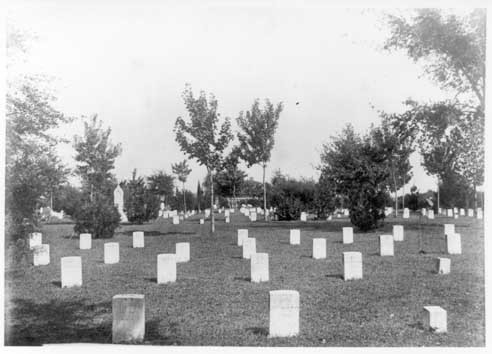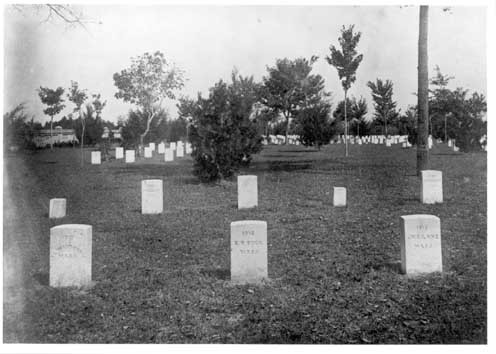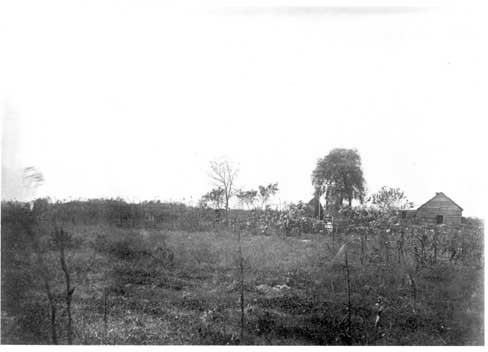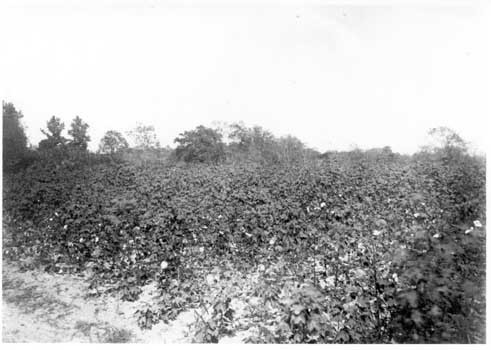Craven County Digital History Exhibit
[New Bern Visit, continued]
Sunday morning
we started for a longer stroll, but the intense heat soon drove us back to
cover. In the afternoon Mr. Street, to whom we had letters of introduction, took
us to drive out in view of the old campgrounds of Stevenson's brigade; to the
National Cemetery (577, 588), where we looked up the recorded burials of
the Forty-fourth men (578, 587) and visited their graves.
|
Photograph 577: Newberne: National Cemetery,
Superintendent's House |
|
Photograph 588: Newberne: National Cemetery, down the main avenue |
The National Cemetery is located on the westerly side of the field on which we used to have our brigade and battalion drills, on the left of the wagon‑road which, passing Fort Rowan (or Star Fort), runs in a northwesterly direction till it crosses the swamp near where Fort Stevenson was located. The grounds are about eight acres in extent, surrounded by a substantial brick wall. On entering, the first object to attract attention is the keeper's lodge, a one‑story and French‑roof cottage, built of North Carolina marl. Opposite the house maple‑trees have been set out in such a way that when fully grown there will be an enclosure in the shape of a cross, roofed by the arching of the [p. 228] limbs. It is known as Sylvan Hall. Trees in every variety that will flourish in the locality are scattered through the enclosure in profusion, together with flowering shrubs. Every grave is marked with a marble headstone engraved with the name of the soldier, if known; in many cases relatives have erected handsome monuments. By enriching the ground with soil from the swamp, a beautiful turf has been secured, which is green when all grass outside is dry and parched by the summer heat; and the whole effect is such that a visitor, on entering, can easily imagine that lie is in a Northern cemetery. The friends of those buried there can feel assured that the last resting‑place of their loved ones is as well cared for and as beautiful as any but the most expensive of our own "cities of the dead." The National Government has provided that in these respects its dead heroes shall be perpetually honored.
|
Photograph 578: Newberne: National Cemetery, graves of
soldiers of the 44th Mass. |
|
Photograph 587: Newberne: National Cemetery, grave of Sgt. Buck |
One woman only is buried here. In 1864, learning that her betrothed, Charles E. Colledge, private in the Twenty‑fifth Massachusetts, had been stricken with yellow fever, Carrie E. Cutter went to New Berne to nurse him. He died, and she, heart‑broken, fell an easy prey to the same disease. Her last wish has been gratified in allowing her remains to forever rest beside those of him she loved so well.
Returning, we saw the mounds of earth representing Forts Rowan (581) and Totten (582, 583). On Monday we went again to these places and photographed them.
|
Photograph 581: Newberne: Fort Rowan |
|
Photograph 582: Newberne: Interior view of Fort Totten |
|
Photograph 583: Newberne: Exterior of Fort Totten, from the Trent Road |
Previous Page: New Bern Visit
Next Page: Washington Visit
Images scanned and text prepared by Victor T. Jones, Jr.This page last edited on 21 Aug 18.










